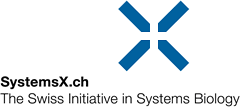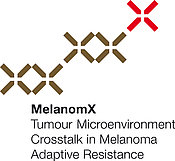MelanomX
Tumor Microenvironment Crosstalk in Adaptive Melanoma Resistance
Inhibition of the BRAF oncogene represents one of the major breakthroughs in the treatment of advanced melanoma. But despite high initial response rates, the patients inevitably experience resistance and disease progression. The MelanomX team is seeking to uncover the mechanisms behind this process in order to fight BRAF-driven cancers in the long term.
Elucidating the key role of the BRAF oncogene has revolutionized the treatment of stage-IV melanoma patients. The pharmacological inhibition of BRAF’s proliferative signaling yields high response rates and improved overall survival. Such successes, however, are limited by the rapid emergence of resistance after a median period of six months. Understanding such resistance mechanisms and overcoming them using innovative strategies is crucial to improving the treatment of affected melanoma patients.
Screening mutations in thousands of cells
The MelanomX project team aims to decipher mechanisms of adaptive resistance to BRAF inhibition in melanoma at the single cell level. The scientists have devised a powerful experimental platform within a clinical setting. It will produce the full transcriptome profile as well as the full mutational landscape of thousands of single cells populating metastatic melanomas. Notably, the experimental design will characterize not only cancer cells but also stromal cell types which constitute the tumor microenvironment (TME). This systems-wide approach will reveal mechanisms of tumor-TME crosstalk during the development of adaptive resistance to BRAF pathway inhibition.
In order to identify the mechanisms that lead to resistance, the scientists will perform systematic biopsies of patients before and during BRAF pathway inhibition, as well as upon treatment failure and disease progression. This way, they will be able to capture the dynamics of adaptation.
At first, the MelanomX consortium will determine the cellular composition of melanomas on a new level of detail by individually analyzing thousands of cells separated from tumor biopsies. The scientists will use the transcriptome data to identify the cell type of every single cell. Later on, the researchers will make use of gene expression profiles to study intra- and inter-cellular correlations and heterogeneity. Genes responding to treatment in a correlated or anti-correlated way will be used to infer intra-cellular biological adaptation to treatment and heterogeneity within the population.
Laying the foundation for new therapies
At the inter-cellular level, systems analyses will identify agents of crosstalk between cell subpopulations that promote resistance, implicating candidate targets for second-generation therapies. Systems biology technologies from across the consortium will be key to integrating such complex data sets and prioritizing biologically relevant modes of crosstalk for the design of new therapies.
MelanomX aims to deliver an unprecedented level of understanding of the adaptive dynamics between cancer cells and cells of the tumor microenvironment, enabling the rational design of next generation combination trials in melanoma that circumvent adaptive resistance to produce more enduring therapies for melanoma patients.
| Principal Investigator | Prof. Dr. med. Olivier Michielin, Department of Oncology, CHUV, Ludwig Center, Swiss Institute of Bioinformatics, Lausanne |
| Involved Institutions | UniL/CHUV, SIB, UniL, EPFL |
| Number of Research Groups | 5 |
| Project Duration | Mar. 2015 – Feb. 2018 |
| Approved SystemsX.ch Funds | CHF 2.124 million |
Updated February 2016


